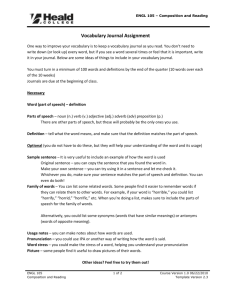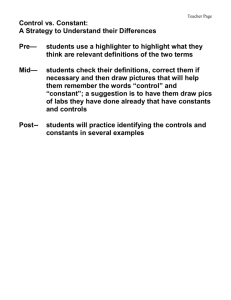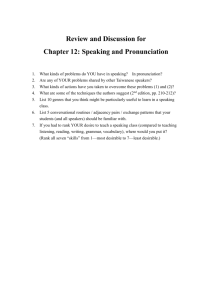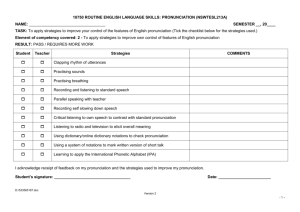Minimal pairs article
advertisement
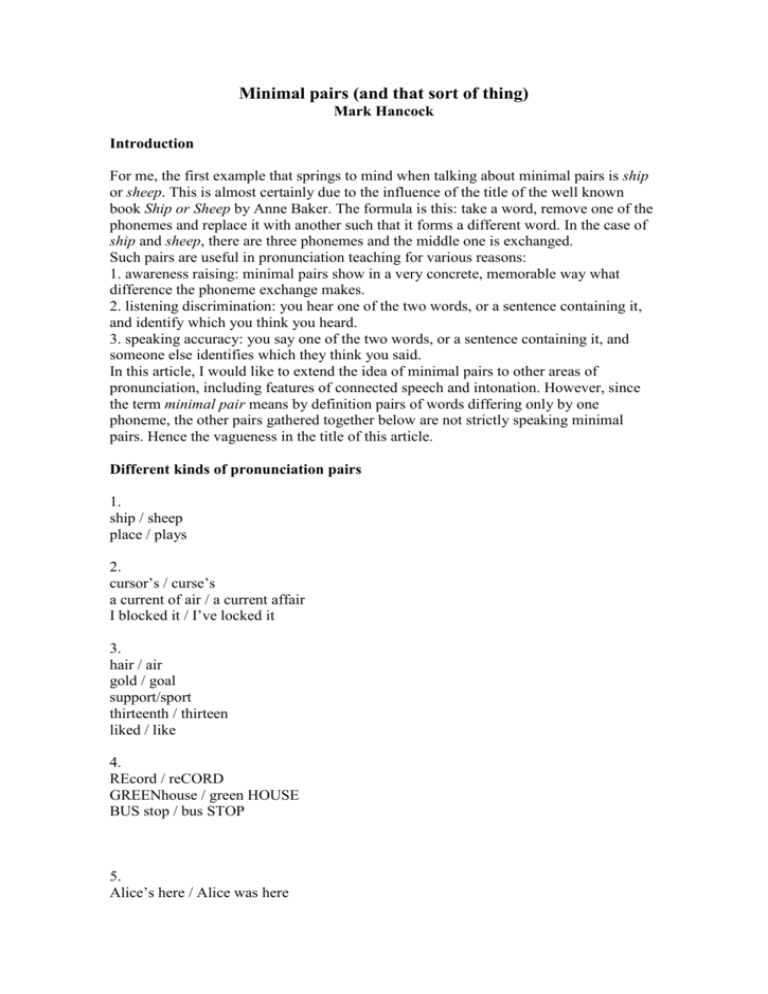
Minimal pairs (and that sort of thing) Mark Hancock Introduction For me, the first example that springs to mind when talking about minimal pairs is ship or sheep. This is almost certainly due to the influence of the title of the well known book Ship or Sheep by Anne Baker. The formula is this: take a word, remove one of the phonemes and replace it with another such that it forms a different word. In the case of ship and sheep, there are three phonemes and the middle one is exchanged. Such pairs are useful in pronunciation teaching for various reasons: 1. awareness raising: minimal pairs show in a very concrete, memorable way what difference the phoneme exchange makes. 2. listening discrimination: you hear one of the two words, or a sentence containing it, and identify which you think you heard. 3. speaking accuracy: you say one of the two words, or a sentence containing it, and someone else identifies which they think you said. In this article, I would like to extend the idea of minimal pairs to other areas of pronunciation, including features of connected speech and intonation. However, since the term minimal pair means by definition pairs of words differing only by one phoneme, the other pairs gathered together below are not strictly speaking minimal pairs. Hence the vagueness in the title of this article. Different kinds of pronunciation pairs 1. ship / sheep place / plays 2. cursor’s / curse’s a current of air / a current affair I blocked it / I’ve locked it 3. hair / air gold / goal support/sport thirteenth / thirteen liked / like 4. REcord / reCORD GREENhouse / green HOUSE BUS stop / bus STOP 5. Alice’s here / Alice was here I like to cook / I like the cook 6. They’re leaving. Soon it’ll be quieter. / They’re leaving soon. It’ll be quieter. Who said “Martin”? / “Who?”, said Martin. 7. Tell me everything She tells me everything, “Blue Mountain” is a “Blue Mountain” is you know. kind of coffee nice 8. Where are you from? South AFRICA. Which part of Africa are SOUTH Africa. you from? 9. I’ve got some bad news for you. I’m afraid your house has burnt down. What? What! 10. wait / weight stopped aching / stop taking greet guests/Greek guests the officers changed / the office has changed Notes: 1. Minimal pairs; phoneme substitution. These are the definitive minimal pairs described in the introduction. The may be used in a variety of ways; see for example Adam Brown’s suggestions (1998). 2. Phoneme substitution across word boundaries. These three examples discriminate /@/ and /I/, /v/ and /f/, and /b/ and /v/ respectively. They work well for awareness raising and listening discrimination, but examples like the second pair will only work for speaking accuracy if the speaker uses weak forms and weak vowels in unstressed syllables. Note that the first pair is only a minimal pair in non-rhotic varieties of English. 3. Phoneme deletion. These raise awareness of features such as h-dropping, consonant cluster simplification and epenthesis. 4. Stress and part of speech. Pairs like REcord and reCORD serve to highlight very neatly the tendency for two syllable nouns to be stressed on the first syllable and two-syllable verbs to be stressed on the second. The second example contrasts a compound noun with an adjective and noun pair. The third example contrasts a compound noun with noun plus verb; the photocopiable page at the end of this article illustrates how this kind of pair can be exploited. 5. Substitution of unstressed function words. Like some of the examples in group 2, these are more pertinent for receptive work than production: it is the weakening of the auxiliaries and other function words which make them difficult to discriminate, and learners are not so likely to weaken them in their own speech. 6. Chunking. In these examples, the chunking is evident in the punctuation. I first saw exercises with pairs like these in Rogerson and Gilbert (1990). 7. Discourse marker or modifier? In pair types 7, 8 and 9, the pronunciation depends on the context (given in italics). In these examples, you know and kind of can function with their ‘literal’ meanings or as ‘throwaway’ discourse markers, and the pronunciation differs in each case. Students could listen to the pairs of sentences and identify which is ‘literal’ and which ‘throwaway’. 8+9. Tonic stress and tone One way of using these pairs is to let the student hear just the responses without the context, and then they decide from the pronunciation which of the two contexts it was from. I first saw examples of these kinds of pair in Bradford (1988). 10. Homophones and near identical pairs These are a special case of pair, where the two words or phrases can sound the same or nearly the same. Obviously, then, they are not much use for listening discrimination, since there is nothing to discriminate. On the other hand, they are very good for awareness raising. The examples here illustrate sound-spelling divergence, linking, assimilation and weak forms respectively. One way of using them is to substitute one member of the pair in a context where the other should go, for example: You should stopped aching those antibiotics. The students then have to work out what the correct versions should be. See more examples in Vaughn-Rees (2002) and Hancock (1995) Photocopiable page 1. Explain and demonstrate the stress difference using the first example “key ring ”: in picture 1a, ‘key ring’ is a compound noun and is stressed on the first word. In picture 1b, ‘key ring’ is a noun plus verb and both words are stressed. 2. Write on the board the following drill pattern. - Have you ever seen a key ring? - A key ring? No, I haven’t. (or Yes, I have) 3. Ask individual students questions based on the other pictures. They must give true answers. If their answer seems implausible (for example, they claim to have seen a jelly fishing by the river), respond appropriately, for example by saying with incredulity “What, you’ve seen THIS?” and point at the picture. 4. After doing this for the six items which are illustrated, the students should have got the idea, so for the remaining items 7 to 17, ask them to explain (in their L1 if necessary) the two interpretations. (note that in the case of item 17, the stress difference is within the word “record”: either reCORD or REcord). 5. Finally, students work in pairs. One asks the questions as demonstrated in step 3 above, and the other gives true answers. References Baker A (1982) Ship or Sheep, CUP, Cambridge Bradford B (1988) Intonation in Context, CUP, Cambridge Brown A (1998) Making minimal pair tasks more communicative, Speak Out! 22 Hancock M (1995) Pronunciation Games, CUP, Cambridge Rogerson P & Gilbert J (1990) Speaking Clearly, CUP, Cambridge Vaugn-Rees M (2002) Conversation in Homophones, Speak Out! 29


